How To Turn Your Hips? Part 3 The Backswing
- by Kelvin Miyahira
Now that we know how the legends used their hips on the downswing, it should make it simpler to understand what to do on the backswing. Since we should already have learned all the anatomical terms last month, this should be much easier to explain. Also, we should realize that we are not coiling on the backswing to uncoil on the downswing. Instead, we should be using the backswing to get us ready to set off stretch shorten cycles during transition that will fire off just before impact. The powerful four combination moves of internal rotation, adduction, hip extension and leg extension are all triggered in transition so we should be mindful of this when performing the backswing.
The Complex
Ambiguous and simplistic terms once again dominate the golf instructional lexicon and we may think we know a good backswing when we see it but it will require re-defining these terms in anatomical terminology in order to ensure understanding.
Hip Anatomy
The only way to really understand the movements on the backswing is to understand how the hip (ball and socket joint) really work. Below are the femoral head and the acetabulum (concave “socket” of the pelvis).
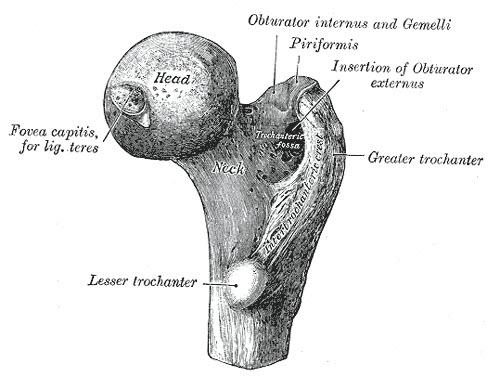
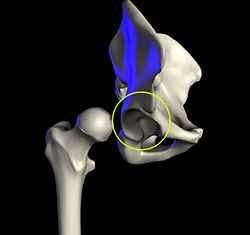
As the hip moves in different ways, the femoral head will shift its position accordingly.
- External Rotation = Forward shift
- Internal Rotation = Backward shift
- Adduction = Upward shift
- Abduction = Downward shift
This can be very easily seen at times but you may have to feel your hip bone movement if you’re not sure. If you’ll press on the outside of your hip joints while moving your hips in different ways, you can feel these femoral head movements.
Added Complexity
But what can also confuse people is that femur rotation can occur along with these movements so we’ll have to keep the microscope on at all times to notice these movements.
Mirrored Movements
Perhaps the easiest way to explain the backswing is that the movements on the right mirror those on the left. There are four mirrored movements involving:
- Adduction/abduction,
- External/internal rotation of the hips,
- External/internal rotation of the femurs and
- Leg extension/flexion.
*For the sake of simplification, I will be referring to the femur rotation as Right Leg (RL) or Left Leg (LL) external or internal rotation.
So let’s take these mirrored movements and see how they interact to create what we call the backswing turn.
This will also help us in distinguishing one type of movement from another so let’s start with the notion of loading your right side versus stacking left.
Loading the right side = RH ADD/LH AB
Ben Hogan, Sam Snead and Jack Nicklaus loaded the right side while Arnold Palmer did not. So what is it that distinguishes their backswings versus Arnie, who stayed on his left side in comparison? Then we’ll have to look at how Arnie completed his backswing compared to today’s stackers.
Here’s Ben Hogan loading his right side. He’s about halfway back on his backswing movement and is still on his right side. But what are we looking at when seeing the weight on the right side?

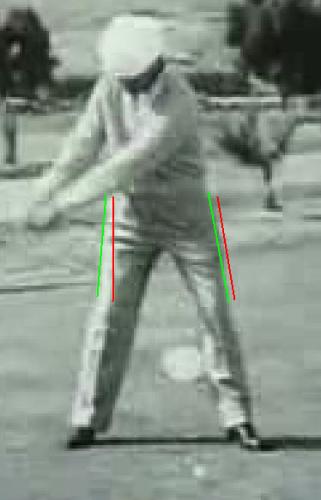
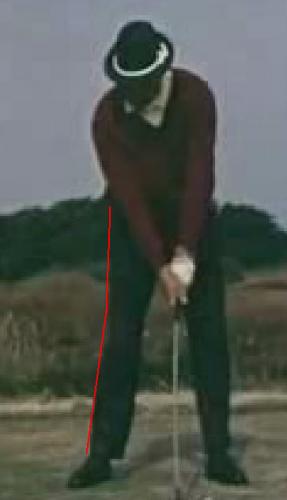

Technically speaking, Hogan and Snead used right hip adduction and left hip abduction to load their right side as they start the backswing. I think most people would agree that this slight movement of the lower body “off the ball” would be considered loading the right side. But really it is RH ADD and LH AB.
Left Loading

In contrast, a left loader or stacker shows the opposite mirrored movements. Instead of RH ADD and LH AB, we see RH AB and LH ADD. Skipping a step maybe?
Right Leg Extension and Left Leg Flexion
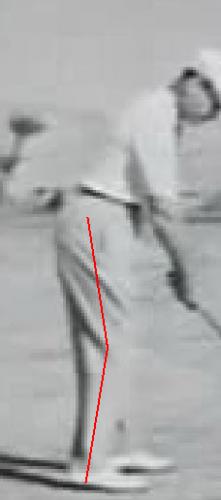
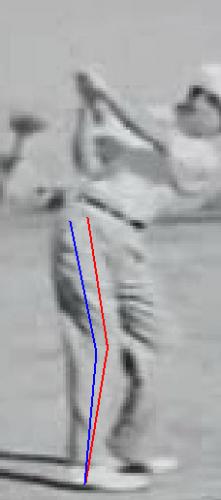
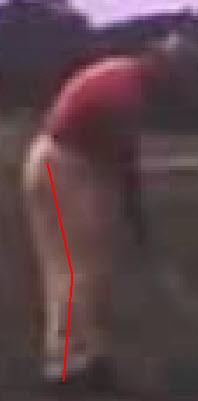

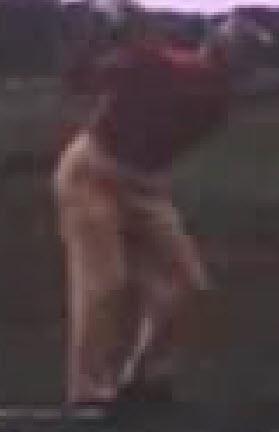
Here’s the next pair of mirrored movements. From this angle we see that Hogan and Snead slightly straightened or extended their right leg while their left knee flexes forward and points out toward the ball.
Right Hip Internal Rotation and Left Hip External Rotation
Just these two movements are what most people believe the backswing hip movement is made up of. RHIR is seen as the pelvis rotating clockwise more than the right leg external rotation. So there is some “coiling” as this occurs.
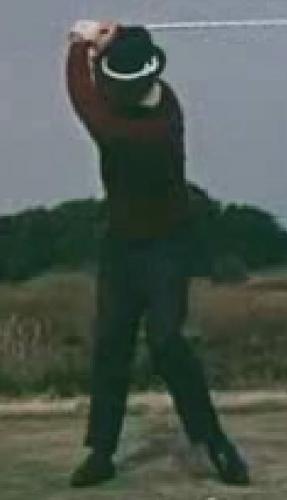
Left Hip Movements
Early in the backswing the left hip slowly moves into ER as the pelvis moves away from the left leg.
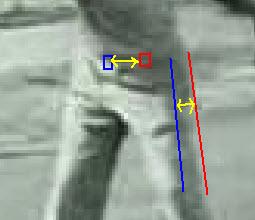
This can be difficult to see so I’ve marked the movement of where his belt buckle and left femur would be at address in red then where it moves to on the backswing in blue. It is clear to see that the pelvis moves away from the left femur until this point.
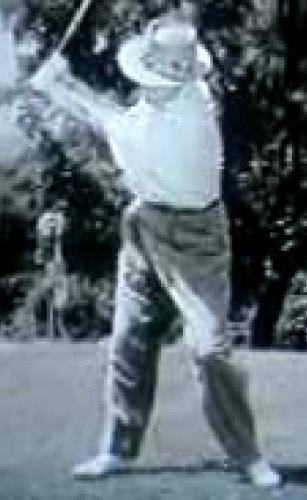
Similar LH ER by Snead.
Right Leg External Rotation
Notice the crease in his right pants leg rotates clockwise on the backswing showing right leg ER (RL ER). This is an extremely overlooked movement. If you don’t pay attention to the rotation of the femur or the crease in the pants, you could easily think that the weight stays on the insides of his right foot and hold IR, thus leading you to believe that you must “coil” or “brace” the right leg when in fact the opposite is true.
There should even be a slight right ankle supination or rolling of the foot outward. This goes against the flow of keeping the pressure to the insides of your feet to “coil” better. If you do that, you severely limit your backswing rotation and most likely lead to early firing of RHIR on the downswing, which can be a swing killer as shown in last month’s article.
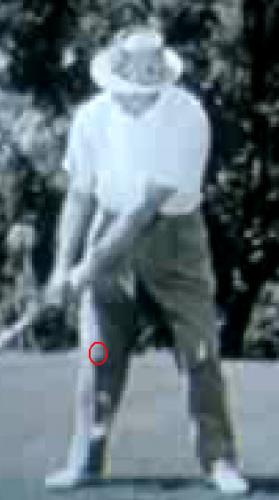
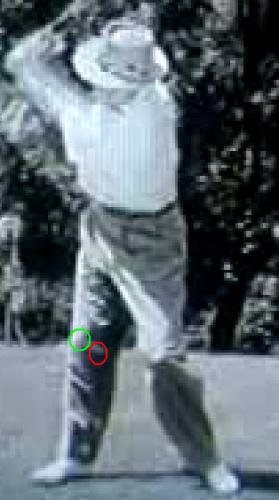
The resolution on this Snead video is not as good as the Hogan one so you’ll have to look at the right knee at the start (red circle) and where the right knee moves to (green circle) to see how his femur has rotated.
Another way of saying this is that typical IR upper limit is 35 degrees of rotation. This means that the most you could turn your hips on the backswing would be 35 degrees if you didn’t add in any femur rotation. And as you can see in the legends, they had “hip turn” of more like 60-70 degrees.
Left Leg Internal Rotation
This movement is far easier to see.
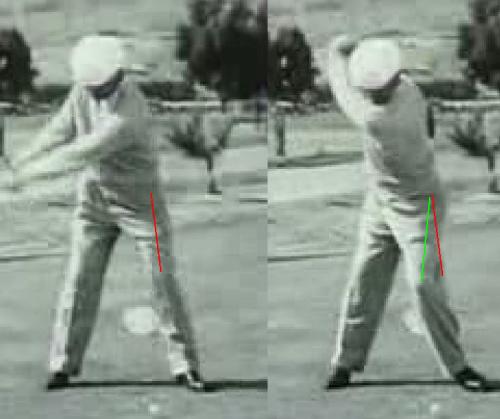
Notice where Hogan’s left femur is after the takeaway (red line). Then he rotates the femur internally and away from the target.
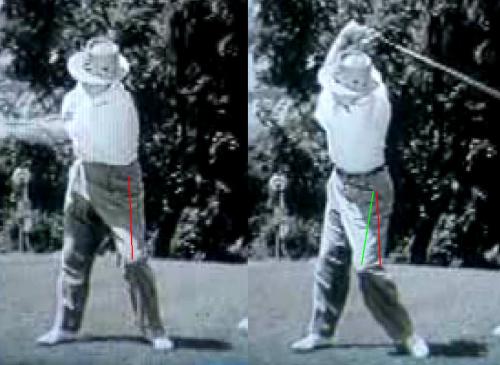
Snead does the same.
Thus, the legends’ answer to a bigger backswing turn was not to be more flexible in their joints and muscles, instead they naturally allowed or did not restrict the four mirrored movements to occur as well. They did not grow up in the era of looking pretty for television. They did not have biomechanical statistics telling them that they should turn their hips 45 degrees and their shoulders 90 degrees. They just did what they did athletically and powerfully.
Late Backswing or Early Transition
The second half of the backswing is where most of the internal rotation of the right hip occurs. Remember the femoral head shift? As RH IR occurs, the femoral head will shift backwards creating what appears to be more turn and even a bit of shift to the left due to starting to move to RH AB and left leg IR (LL IR).
Most of the RL ER slows/stops and the pelvic rotation begins to surpass the leg rotation.
It is only after this point that Hogan shifted left during his transition. Transition movements are RH IR, RH AB, LH ADD and LL IR.
The left side movements used by Hogan and Snead are characterized not by position but by the leg whipping action that whirls them into LH ER and pelvic rotation that occurs in transition.
Jack Nicklaus Pattern
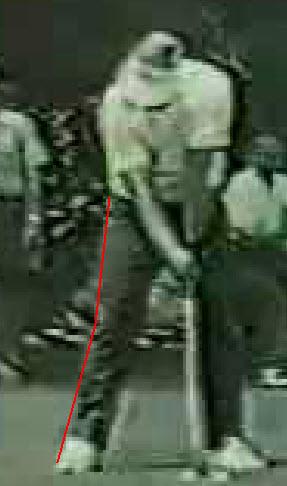
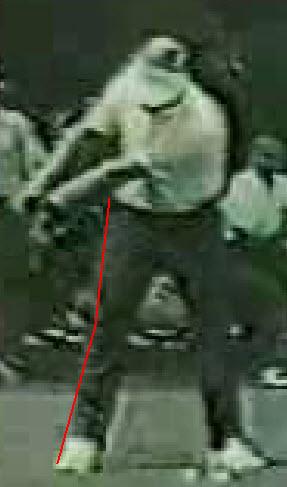

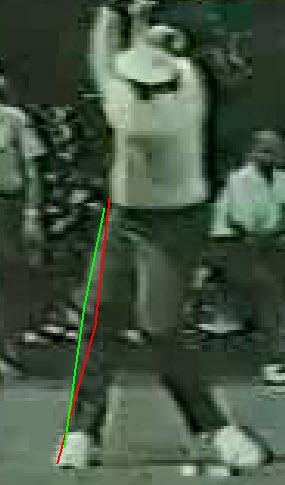
Jack used a different pattern than Snead or Hogan. He slightly used RH AB early as seen in the 2nd picture which would make him sort of seem like he was a left loader. Then he used RHER and IR/ADD during the second half of the backswing. This changes his position and allows him to load his right side.
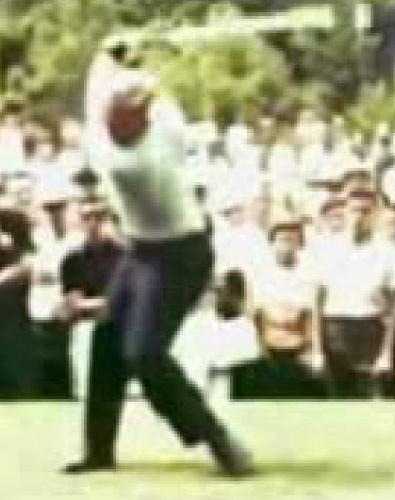
Jack looked more like a long drive competitor at the top of his backswing than a stack and tilter in his younger days (prior to being taught to keep his head perfectly still). No wonder he was so powerful and could dominate.
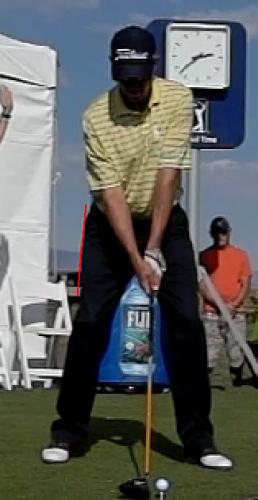
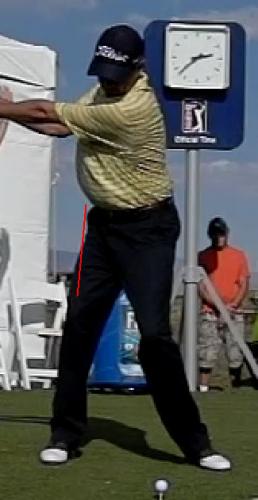
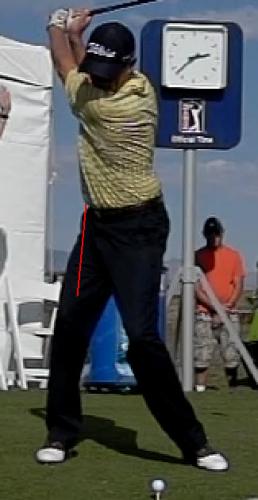
If you’ll look carefully at Davis Love III’s backswing, he uses a similar pattern as Jack. The second picture shows more space between his right hip and the red line which means he used RH AB instead of ADD at the first half of the backswing. But by the top of the backswing he moved more laterally to the right by using RH ADD.
Thus, while it might be a different sequence than Hogan or Snead, they do possess all of the four mirrored movements. Therefore, they have the potential for a great swing.
Arnold Palmer vs. Stack and Tilter
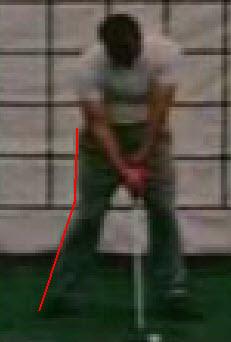

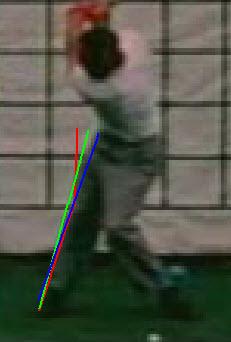
We know Palmer had a more centered pivot but, is it the same as the modern stack and tilter?
In a close up of Arnie, we can see that there are key differences!
Close up of Palmer shows he actually did use some RH ADD initially (moving from red line to green line) in the takeaway but then moved to RH AB by the top of the backswing. The RH AB, large amount of RH IR and LH IR/ADD is what causes it to look like he’s more centered in his pivot. The key difference is that he’s got a huge backswing “hip turn” and he’s ready to move into the same positions as Snead in transition.
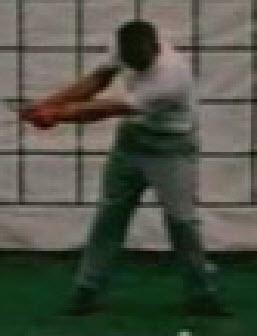

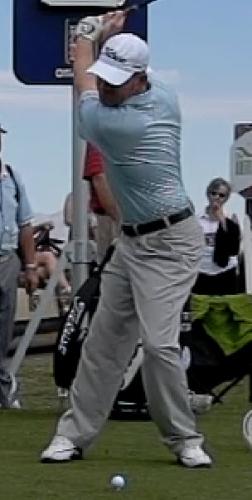
There are slight differences in the hip position between Palmer and Matteson. Palmer has a little more tilt in his hips which is due to more flexion than Matteson.
But, Palmer has way more LL IR and this is the key to his tremendous leg whipping ER in the downswing. By contrast, Matteson holds strong LHER and LL ER that might trigger IR in transition?
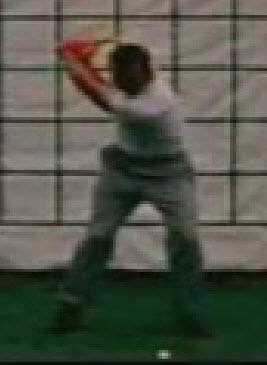

After transition, Palmer has his legs in the classic squat position of dual ER/AB whereas Matteson is in the dual IR/ADD position. Notice Troy has his right heel off the ground already indicating early extension and more lateral push to the target. Also, his left leg is staying in ADD vs AB that Palmer is in.
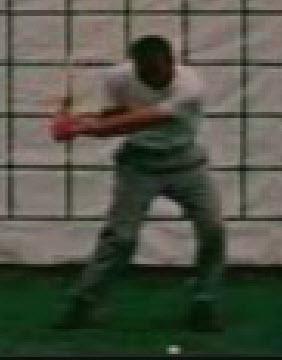
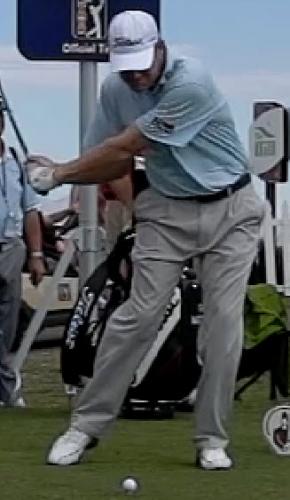
Palmer is rotating using more LH ER and glute power on the left side while Matteson is holding LH IR and hindering pelvic rotation. On the right side, Arnie held ER/AB in transition and is only now starting to fire IR/ADD while Matteson, who fired IR/ADD at the start of the downswing has very little possibilities left.
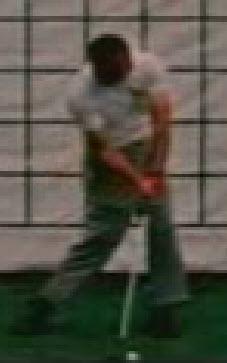
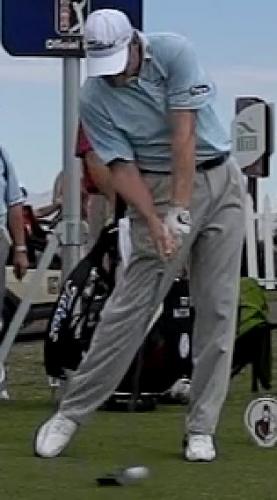
Palmer whips his left leg back, away from the target in ADD, IR and extension. Troy has run out of IR and is extending while still sliding laterally. One can see how Palmer looks a lot more rotational vs. Troy, who looks like he is moving more laterally.
For many of the amateurs trying to stack and tilt with less time to practice and less athletic ability than these tour guys, the key to a legendary swing is to copy Palmer’s moves. And the one major difference is in the LL IR/leg whip action that unweights the left foot to allow rapid ER of the left leg in transition. If your weight remains heavily on your left leg, LH ER is impeded and all you’re left with is to slide and extend. Maybe that’s what you think you want to do and what you’ve been told to do but it isn’t legendary or athletic.
Hip Equations
Perhaps this can make things easier to understand. The legends use mirrored movements during the first ¾ of the backswing and they are comprised of:
RH ADD/LH AB + RL ER/LL IR + RL Ext/LL Flexion + RH IR/LH ER
These four mirrored movements create “hip turn” and legendary backswing. If one or more of these movements is missing, it creates dysfunction or a bad pattern that will be difficult to overcome in the downswing.
Less than Legendary Patterns
Restriction of Right Leg External Rotation
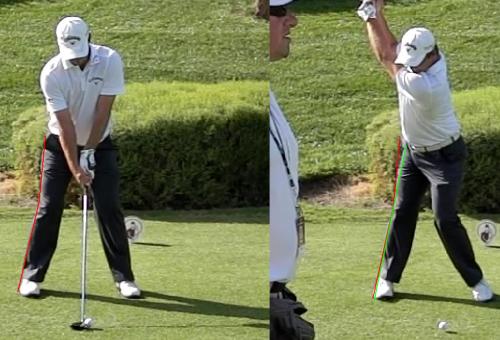
This is probably the most common error of the amateur. The right leg ER is restricted or holding his right knee inward along with slight AB in the backswing. Now that’s coiling! Do that and you will fire off with that right leg/hip internally to start the downswing!
Without Right Leg External Rotation and Left Leg Internal Rotation
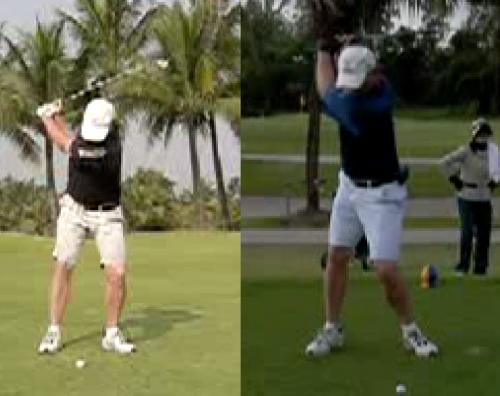
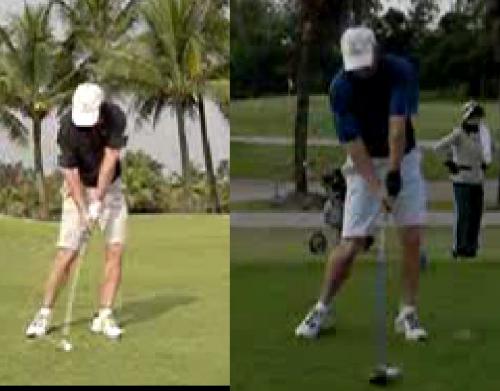
Here’s a golfer without RL ER and LL IR on the backswing in the “before” pictures. Notice how this extremely restricts his backswing turn.
In the “after” pictures (darker pics), he has correct RL ER and LL IR and you can see what it can do for his body rotation at the top of his backswing and at impact. Some work with the Impact Snap and Lag Device has also helped move his left arm into a far better position and cured the flip.
No Right Leg Extension

Here is an example of what the loss of RL extension can do. It restricts your backswing movement so that you lose hip turn.
Though a scratch player at 67 years old, he’s learning to improve his backswing. By extending his right leg a bit and adding more RH IR/LH ER he’s got a bigger “hip and shoulder turn.”
Stacking Left = No RH ADD

In this swing, there is RHER but huge move to RH AB in the backswing. In other words RH ADD is missing.
So this fellow skips a step or two and goes straight to RH AB and LL IR at the start of the backswing. This would be like a baseball hitter starting with his weight on his front foot and being a powerful hitter. Not likely.
What’s a sway? Restricted RH IR, RL extension and LL IR
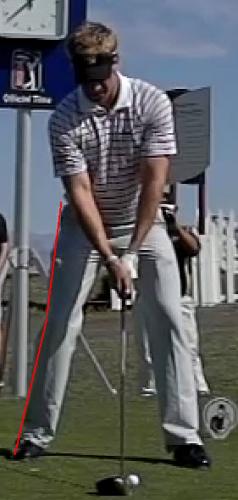
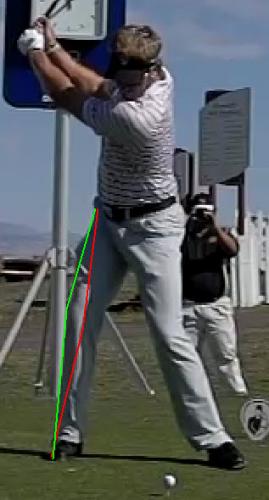
There are several ways that could be considered swaying. Ricky Barnes has RH ADD/LH AB at the start of his backswing but does not straighten or extend his right leg much and has a bit more right ankle supination (his foot rolls outward). By limiting the leg extension and RH IR at the end of his backswing, this can lead to a sway and a restricted “hip turn” as you can see.


If Ricky would use RH IR near the end of the backswing he would be able to turn his hips more like Snead or Palmer. In this case, the cure might be to feel more like Arnie’s hips that are more on the left side at the top of the backswing.
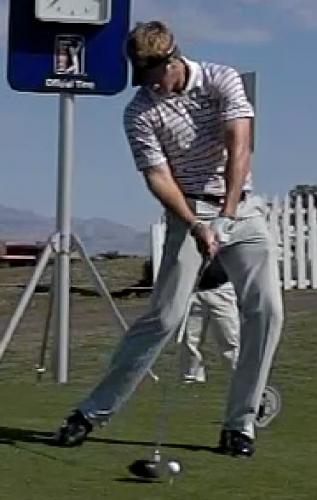
Then perhaps, he wouldn’t need to slide so far forward on the downswing?
Weight Shift
Keep the weight on the insides of your feet???
How many of you have been told to keep the weight on the insides of your feet? Or don’t sway? Or keep the pressure on the inside of your right leg? Or how about turn your shoulders while resisting the turn in your legs?
Now of course you don’t want to take it to an extreme and sway too far to the right but for many amateurs this is a swing killer. All of these notions will ultimately lead you to limiting RHER. And as we’ve seen with the legendary swings, they all use ER in the legs to create the squat move. Thus, whether on the backswing or downswing, you must allow the weight to move to the outsides of the feet and allow both femurs to rotate externally or you will severely limit the amount of available moves. In other words, you will create a stall at some point in your swing.
And as we have seen in dysfunctional swings, the early firing of RHIR in the downswing is the cause of many amateur errors.


Instead of holding the weight on the insides of their feet, the legends got a little more on top of the right foot with RH ADD/LH AB.
Remembering that the thoracic spine extends slightly (TSE) which keeps the head/top of spine from moving too far to the right, this along with the four mirrored movements of the hips/legs will create a legendary backswing.
Upper Body Weight Shift
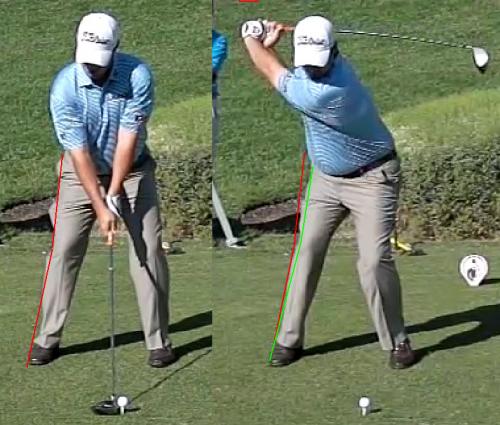
Some people focus on the upper body creating the weight shift. This would create a flexion of the spine (opposite of TSE) and in order to balance the body, the lower body would move into the opposite hip movements of RH AB and LH ADD. This is not quite legendary.
Left Heel: To Raise or Not to Raise?



Snead, Nicklaus and Palmer all lifted their left heels upon completion of the backswing.

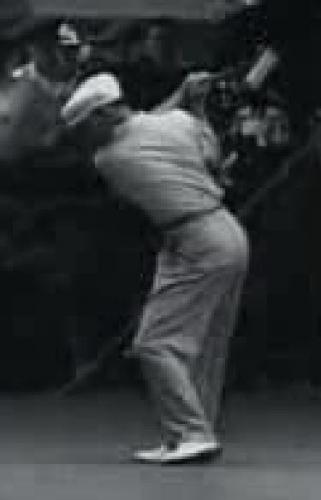
Only Hogan kept his left heel flat although in his younger days he certainly lifted his heel and may have shortened his slightly long backswing by removing the heel lift.
So the obvious answer is YES! Especially if you’re over 40 years old and are losing flexibility, you should lift your left heel for two reasons; one is to create as big a backswing turn as you can without restrictions and two, the heel lift is part of the left leg IR that is going to help whip your left hip into ER in transition to get to the squat move or dual ER.
Seniors Take Note
Especially for those over 45-50 years old, there should be a conscious attempt to try to get a bigger backswing. Unlike in your 20’s or 30’s when you are still flexible and may have had too long a backswing………you may want to take a fresh look at your backswing to see what you’re missing so you can regain some of that lost “turn” and yardage.
Stretch Shorten Cycles
Another way to view these movements would be to see how the backswing movements create SSC’s for the transition.
RH ADD >> RH AB
RH IR >> RH ER
RL Ext >> RH Flexion
LH AB >> LH ADD >> LH AB
LH ER >> LL IR >> LH ER
Conclusion
Turning the hips on the backswing is a complex movement involving the mirrored movements of the spine, pelvis, hip joint articulations, leg and even foot/ankle movements. We’ve got to look at the legends for help in this important part of the swing since most of the current pros are looking so pretty and “efficient” that it is difficult to see these movements in all their glory. Or look at the great young players like Bubba, JB and even Tommy Gainey that haven’t been trained out of great movements in order to see how someone athletic would swing if left to their own creations.

